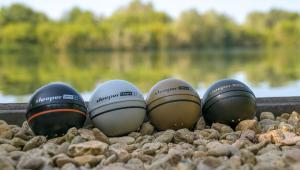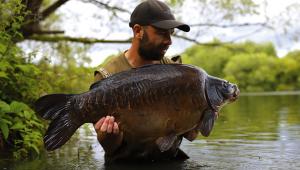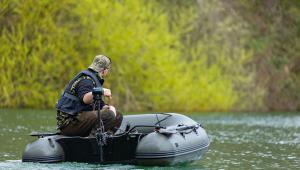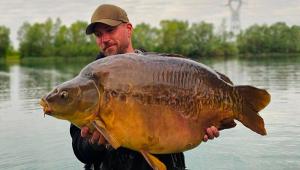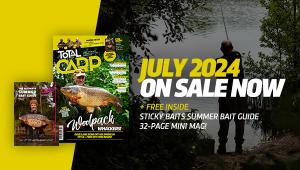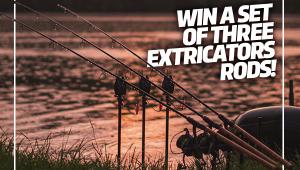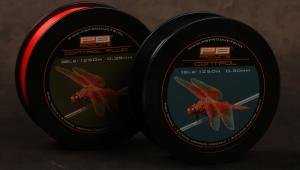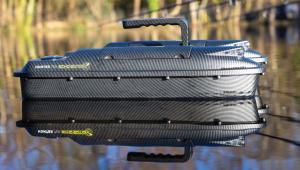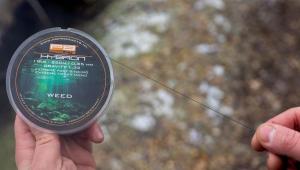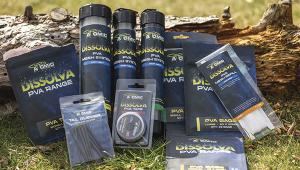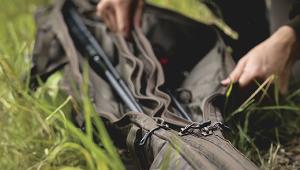BIG CARP MINDSET | a new start
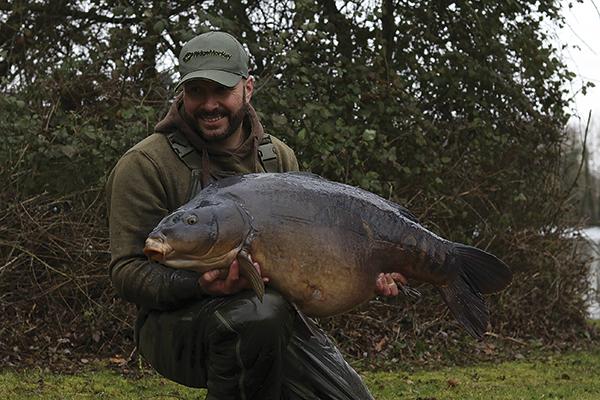
If, like me, you are an angler with a busy home and working life, short sessions such as overnight trips are very often the only way you can guarantee time on the bank. Spring offers the first few rays of hope following a dull winter and you start to believe that now is the time your short sessions might begin to turn productive and you won’t be setting up and packing away in the dark, all to no avail.
As I described in the first part of this series in the December 2016 issue, I had decided to target RK Leisure’s Horton complex and fish Church Lake because it not only has a prestigious and, in my eyes, history-rich background but it is also home to some very large carp that make up a stock of around 70 to 100 fish, depending on who you ask, in some 15 acres of weedy and pressured water.
It’s no secret, and has probably been written about more times than I can count, that spotting fish and moving onto them at this time of year is far better than a mass baiting campaign where you sit and merely hope they will come to you. Like many, I spend as much time looking for fish as I can when out on the bank. However, it isn’t always a case of turning up and being pleasantly greeted by an acrobatic display of hungry carp. In fact, this can be described as a rarity.
Church Lake was due to shut for two weeks on March 15th before the new tickets start and with limited time I wanted to make sure my next few sessions counted.
This time last year I was unfortunate to lose one of the lake’s biggest residents from a swim known as The Salt Circle. While some called me mad and others delusional, I honestly believed that this would be where I would get my first chance of a Horton carp in 2017. Of course, if I were to see fish elsewhere I would have no hesitation but to pack down and move.
The swim isn’t the most fished or desirable on the lake, but I like this. I believe that doing things differently and targeting quiet spots could give you an advantageous edge over the anglers around you.
So with my swim choice made up I wanted to find a good area to fish too. Now each swim has recognised hotspots, so I did found the prominent hard gravel spot that I know does bites throughout the warmer months but opted to find the softest substrate around that. Gravel offers absolutely nothing in terms of natural food content compared with softer detritus deposits or siltier areas. However, come the autumn, when the carp are openly looking for food, I will have no hesitation presenting them with a large offering on it. With the naturals in the lake now also beginning to wake up and emerge, just a few moments spent watching the immediate margins began to reveal various larvae; I felt that the carp would instinctively go in search of these areas because they don’t know anglers are going to descend onto the lakes and attempt to give them a feed. So where would the naturals be now? I have often found these areas more likely to be soft, silty substrate, that is why I always give them a very gentle sprinkling of bait and begin there.
I always opt for a gentle approach throughout spring because the carp have often been sitting up during the winter and cold conditions, especially when the lake has had an icy hat on for a few weeks like Horton had. As a result, they cannot continue to feed on anglers’ baits. I believe the carp enter what’s almost like a dormant stage throughout this period, burning body fat rather than eating. I liken it to having a gastric band fitted, both their appetite and digestive tract shrink so they can’t start off gorging themselves on the volume of bait that they would perhaps consume in autumn, for example. If I did start piling a load of bait in, I am sure they would eat some but I would have overfed them and they would have to eat an awful lot more before they reach my hook bait, in theory. Instead, I go in with a little-and-often approach. I can still prebait before leaving but only putting out 10 Spombs as opposed to 30. For example, on arrival I might put out five Spombs. If I haven’t had anything throughout the night and I am staying on for a few more hours, just two to top the spot up will suffice. Remember, this is a relatively low-stock venue. If there were several hundred fish present I would probably double the amount of bait but still start with more crumb than whole boilies.
Bait choice is also key and I always start with Mainline Hybrid and Essential Cell boilies that I run through the RidgeMonkey Advanced Boilie Crusher to gain a coarse but fine mixture, as contradicting as that sounds. The Hybrid is a lovely food bait with a good winter record, while the Essential Cell is an extremely visual bait and with ethyl alcohol flavouring it means that the flavours will still disperse and leak off even in cold-water conditions.
I try to fish this crumbly mix over an area as opposed to tightly baiting on just one spot. With the carp now moving around the lake, albeit slowly, and I do believe in close groups, I want to get them picking bits of bait up and moving, sifting their way throughout an area perhaps up to two rod lengths long with my bright hook baits among it.
With that said it is all about watching the water and reading it. At the risk of sounding too hippy here, you have to be in tune with the water. For instance, I prebaited this area with crumb but when I got down and began to deploy more crumb over the mix, I was quick to notice the diving birds would go down on the spot repeatedly, come up to the surface, and eat away merrily. Now I know it will take a long time for the ducks to eat every morsel but they are creating enough movement on the spot that it could potentially disperse the bait over an even bigger area and dilute the scent. So, when it came to topping up I opted to fish with whole boilies, but again in a very small quantity. As I sat back and watched, the birds came along and began to dive on the spot. However, as soon as one rose from the water with his boilie prize in his beak, a swarm of gulls descended upon him and after a fair few squawks and thrashing around he decided that it wasn’t worth his effort, leaving my spot to rest and the bait in position.
Singles can of course serve you well at this time of year. A bright bait isn’t so blatant in spring; it’s exactly what the carp are looking for. Sending off rich food signals in a highly visual way, it is almost too obvious for the carp to ignore. It also comes down to the numbers game. If 80 per cent of anglers are fishing these tactics then it stands to reason they will catch a carp between them. However, I find it hard to sit on my hands over three single pop-ups if I haven’t seen fish in that area.
With limited time, I like to try something different; testament to this is what I was told last year: “The Horton carp won’t eat a round bait in the edge.” Naturally, I was dubious. They will eat round boilies in the middle of the lake but not the margin? Sorry, I can’t accept that and as a result of bucking the trend I caught five or six fish on round boilies in the margin that year. When you can’t afford to be down the lake as much as some of the other guys, make sure you are making your time count and standing out from the rest. In fact, try to predict what is going to happen and use this to your advantage. It does take time but you have to watch the water and try to understand what is going on; don’t be afraid to try something different.
There are several rig options I would look to fish when targeting a softer area and each is purely chosen by what substrate I am fishing on.
When fishing a firm, silty area I tie a short stiff-hinged presentation. A fluorocarbon boom with a chod-style pop-up section sitting around half an inch off the bottom offers me a good presentation. When used in conjunction with a helicopter lead arrangement to a drop-off Heli-Safe system I can gain good line lay and sensitive bite indication. The boom section is quite pivotal in that with the gin-clear nature of the lake I want my approach to be as disguised as possible and the new material soon to be released by RidgeMonkey literally disappears when entering water. The only thing I want to stand out and catch the carp’s eye is my hook bait.
On some of these areas I have been talking about fishing, there is still an amount of weed present and again this is where you will also find natural foods. If I believe that my hinged rig will not provide me with an ample presentation then I always opt for a chod rig on a lead-free leader and again a drop-off helicopter style. Dropping the lead is essential in getting the carp off the bottom and out of the weed, which could potentially be a problem.
With a stiff hinged rig placed on the firmer silt and two chods deployed to the softer end of the area, this is where my tactics would either prove successful or the night would add to the ongoing tally before my next Horton carp.
I was awoken the morning Dan Murrell was set to arrive to take the relevant pictures to accompany the piece because the rod fishing the stiff hinged rig gave a few bleeps. Thinking it was a swan that had previously caused me dramas, I slipped my shoes on, turned the receiver off and went to sort it out. I was pleasantly surprised to see that the clutch was going but not in a violent manner, rather surging in short, slow runs.
The fish hit the surface as soon as I picked up the rod and began to apply pressure. Slowly and steadily a good-sized carp wallowed on the surface, making its way to the net. Not really putting up a scrap, I thought I had hooked a good fish in the upper-twenty region. Well that’s what I would have described it as if it had fallen off. I rang Dan to let him know I had a decent fish waiting and could only keep it if he wasn’t far away. After trying to weigh the fish I then rang him back to alarm him. It was in fact a very big carp and I needed him now! True to form, five minutes later he came bounding into the swim having set off early hoping to get down and shoot a good feature.
As we hoisted the carp up with our shaky excitable hands, the needle came to rest at 50lb 2oz, Horton Church Lake’s second ever 50lb carp and my biggest ever while out on a feature.
As you can imagine, the next few hours drifted past as I soaked up what had happened with a flurry of photographs, celebratory text messages and phone calls and this very feature.
The other anglers retreated to their swims and was set to leave, so I sat back flicking through the images of a truly special moment, safe in the knowledge that my approach and work had paid off, and I believe it could for you, too.
I know some of you might not necessarily be targeting a venue with this calibre of fish and might think it doesn’t apply, but it really is irrelevant what fish or venue you are targeting. This tactic has proved fruitful throughout spring on a variety of waters up and down the country and resulted in many different sized carp. The fundamentals never change; you must make a plan for your approach because fish won’t always present themselves in your short angling windows. Learn as much as you can from the lake just by watching the water, bird life and everything around it. Most importantly, learn from your experiences and other people’s but be ready to change and don’t constrict yourself to the going method.
I wish you all a productive spring and hope you can take something from this piece. Until the next instalment, enjoy your time on the bank.
- Log in or register to post comments
